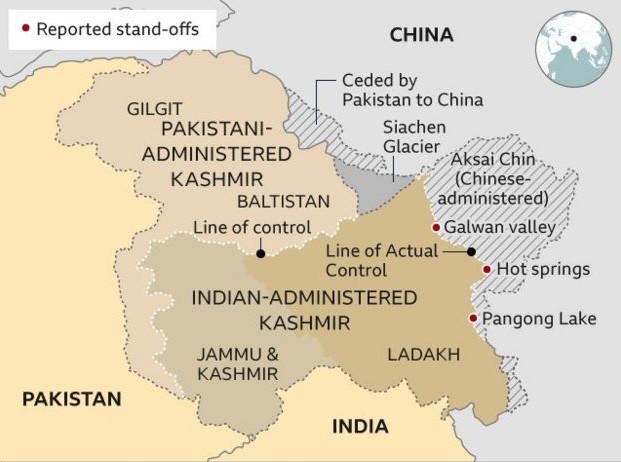The months-long India-China border tension in the eastern Ladakh region could very well spread to India’s northeastern periphery if the two sides fail to reach a consensus soon. Reports suggest there has been a massive Chinese buildup along the Line of Actual Control (LAC), the de facto border between the two Asian giants, opposite Arunachal Pradesh. The picturesque Indian state shares one third of the total 3,488-km LAC with China, but the latter considers it to be only around 2,000 km.
Apparently, the Chinese People’s Liberation Army (PLA) has deployed a large number of troops and a heavy arsenal at several points on their side, 20 km from the LAC. The areas opposite the Asaphila, Chantze, Tuting and Fishtail-2 sectors are witnessing troop movements, according to media reports quoting Indian army sources. The Indian troops have also beefed up their vigilance and strengthened their positions to thwart any possible incursion bid by the Chinese.
Arunachal has long been a cause for dispute between New Delhi and Beijing, with the latter claiming it to be a part of southern Tibet. China’s foreign office repeatedly makes statements to this effect. Most recently, on Sept. 8, the state-run Global Times quoted Chinese Foreign Ministry spokesperson Zhao Lijian reiterating his country’s stand while talking about five missing youths from Arunachal.
On Sept. 5, Tapir Gao, an Indian member of parliament from Arunachal East, tweeted alleging that the five youths from Upper Subansiri district were “abducted” by the Chinese PLA. Later, it emerged that the boys had gone hunting in a remote area on Tungdara Mountain close to the LAC. They reportedly strayed into the Chinese side and were detained by the PLA. Indian army officials then contacted their Chinese counterparts and the five youths were returned at Kibitu, the easternmost town in India, on Sept. 12.
Chinese aggression not new
The latest physical confrontation between the armies of the two nuclear powers in the Ladakh area was triggered by China’s bid to unilaterally redraw the LAC. The Galwan Valley incident of June 15, in which 20 Indian soldiers and an equal or higher number of Chinese troops were killed (China has not officially released any casualty figure yet) is said to be the deadliest clash in over five decades. No firearms were used in the fight as per the provisions of a 1996 agreement.

India had accused China of resorting to “provocative military movement” and violating the border consensus reached between them, something China vehemently denied. The last time the two armies had a major encounter was in 1967, at Nathu La and Cho La in Sikkim, resulting in scores of deaths.
In 2017, an ugly 73-day standoff on the Doklam plateau near the India-Bhutan-China trijunction worsened India-China ties. Needless to say China’s attempt to build a road near the disputed border was the trigger for that impasse. Finally, both sides agreed to withdraw their troops to their original positions. However, as is its wont, China is now reportedly building infrastructure to house air defense systems near Doklam.
Blast from the past
The India-China border conflict has a bloody history. In the summer of 1960, then Chinese Premier Zhou Enlai met his Indian counterpart Jawaharlal Nehru in New Delhi in order to find a solution to the border row. He made an offer that China would recognize India’s claim over Arunachal up to the McMohan Line provided New Delhi considered China’s claim over the Aksai Chin peninsula. Proposed by British administrator Sir Henry McMahon in 1914, the eponymous line is the eastern portion of the LAC between Tibet and India’s Northeast.
Nehru turned down the offer, following which China took a series of aggressive military actions in the next two years, including the resumption of forward patrols in Ladakh that it had ceased two years prior. On Oct. 20, 1962, the Chinese army captured the areas along the contested border, resulting in a war. It took over Arunachal’s Tawang in the east, and Rezang La in Chusul in the west. The troops advanced towards Tezpur town in Assam before Beijing unilaterally declared a ceasefire on Nov. 20. As many as 1,338 Indian and 722 PLA soldiers were killed in the monthlong war.
While China had withdrawn from India’s Northeast, it retained Aksai Chin in the west. According to an an Indian security analyst, “The defeat at the hands of the Chinese is something Indians will find hard to accept. In fact, this episode is seen as a key reason affecting bilateral relations between the two neighbors.”
Trade ties
The two sides are currently engaged in military-level talks, but there are no signs of a breakthrough yet. Beijing, however, states that it does not want the border dispute to affect bilateral cooperation. So far, the Galwan episode has failed to make any impact on trade ties as India’s exports to China witnessed a 23.7-percent year-on-year increase to US$1.74 billion (2.29 trillion kyats) in July.
New Delhi, however, seems to be treading cautiously while maintaining trade relations with its neighbor. Within India, experts call for reducing trade dependence on China. In April, the Narendra Modi government tightened its Foreign Direct Investment (FDI) norms in order to prevent what it called “opportunistic takeovers” of firms hit by the pandemic-triggered lockdown, a move seen as aimed at China. At $8 billion (as of December 2019), China is the biggest investor in India among the countries the latter shares borders with.
The Xi Jinping regime would do well to give up its aggressive posture and take the lead in defusing the border row with India given than there is a worldwide negative perception against China in the wake of the Covid-19 outbreak.
Jayanta Kalita is a senior journalist and author based in New Delhi. He writes on issues relating to India’s northeast and its immediate neighborhood. His views are his own.
You may also like these stories:
Despite China’s Wishes, a Canal Across Southern Thailand Is Still a Distant Prospect
ASEAN Talks Begin With Pandemic, S. China Sea, Rohingya on Agenda
















